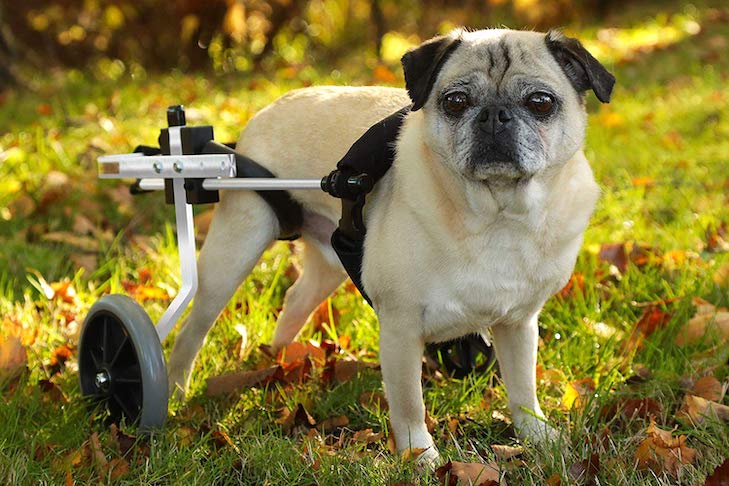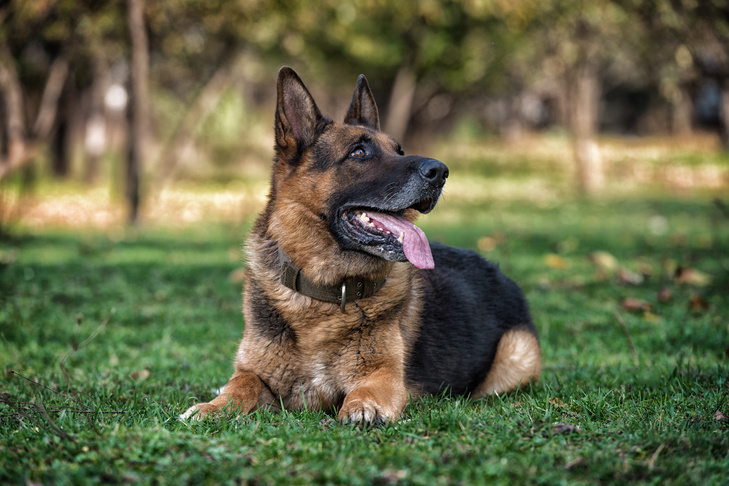Canine degenerative myelopathy (also known as DM) is a spinal cord disease. DM can result in gradual paralysis in dogs, starting in the hind legs and moving toward the front. It usually appears in dogs that are middle-aged or older.
There is no effective treatment available for DM in dogs, and no cure. In fact, the condition usually progresses to the point of euthanasia, out of concern for the dog’s quality of life. However, scientists are doing a lot of research on DM to learn more about the disease and how they might be able to treat it.
What Causes DM in Dogs?
What is DM in dogs? In many ways, DM is similar to some forms of ALS (Lou Gehrig’s Disease) in humans. Both diseases involve degeneration in certain parts of nerve cells and affect spinal cord motor neurons (the nerve cells that control voluntary movement).
To better understand how these diseases affect neurons, let’s take a look at the way these cells work. In nerve cells, or neurons, the axon is a long tendril responsible for transmitting nerve impulses over distances to the next neuron. In many neurons, myelin sheaths help with speed of transmission along the axon. Myelin sheaths are a fatty, white layer that protects the axon and maintains the strength and speed of the nerve impulse.

When bundles of axons travel together, all that myelin gives them a white appearance (which is why it’s called white matter). Some diseases, such as multiple sclerosis, ALS, or DM, destroy the myelin sheath, which gradually destroys the nerve’s ability to transmit signals. Results include weakness and paralysis.
Human ALS has been shown to have many different causes, including some known hereditary factors. Variants of a gene called superoxide dismutase 1 (SOD1) are associated with the majority of hereditary ALS cases, and most, if not all, cases of DM in dogs. Among other changes in the nervous system, these variants cause a substance called glutamate to accumulate. Glutamate accumulation can lead to myelin destruction and neuron death.
Signs and Symptoms of DM in Dogs
The first signs of DM can be subtle, like your dog dragging a rear foot, having a wobbly gait, or taking a wrong step here or there. With time, signs of canine DM progress to swaying, falling to the side, loss of coordination, worn nails on the rear paws, walking on their knuckles, and even difficulty getting up.
Eventually, the dog’s rear legs weaken, then become paralyzed. After that, the paralysis moves forward, affecting the front legs until they no longer work, either. Paralysis can continue progressing all the way to your dog’s head.
Your dog may also be unable to control pooping and peeing, or lose the ability to pee on their own. In fact, not peeing can be a medical emergency, so you’ll need to bring your dog to the vet if they haven’t peed in 24 hours. Owners may also need to learn how to express their dogs’ bladders.
DM seems to be more common in some breeds, like Pembroke Welsh Corgis, German Shepherd Dogs, Boxers, Rhodesian Ridgebacks, and Chesapeake Bay Retrievers.

How Is DM in Dogs Diagnosed?
Your vet may start to diagnose by noticing signs consistent with DM, like gradual rear end weakness. But rear end weakness can also be caused by other problems. In the end, diagnosing DM involves diagnosis of exclusion, meaning your vet makes a diagnosis once they’ve ruled out other possibilities.
Ruling out other possibilities may involve tests, including blood work, radiographs, spinal fluid analysis, myelography (where X-rays show the fluid around the spinal cord), computed tomography (where X-rays allow a vet to see cross-sections of your dog’s body), and magnetic resonance imaging (MRI). Electromyography and nerve conduction studies, which measure how much a dog’s nerves have changed or been damaged, can show abnormal results in a dog with the later stages of DM.
DNA Tests for DM in Dogs
DNA tests may also help provide insight about whether your dog carries genetic risks for DM. In 2009, researchers found that many Pembroke Welsh Corgis with DM, as well as dogs from several other breeds, had a variant in the SOD1 gene. Bernese Mountain Dogs also have a high frequency of DM, but the cause appears to be a different variant in the SOD1 gene. No matter the breed, it appears that dogs with DM had two copies of one or both genetic variants.
However, not all dogs with a pair of the variant alleles will develop DM. Some experts believe attributing DM to just a SOD1 variant may be an oversimplification. Other factors seem to influence whether or not the SOD1 variant is expressed (also called penetrance).
Dr. Joan Coates, professor of neurology and neurosurgery at University of Missouri Veterinary Health Center, was one of the original researchers who found the SOD1 variant in dogs. “A dog that tests at risk has higher likelihood of developing DM in later life,” cautions Dr. Coates, adding that scientists are continuing to work on understanding the variant’s penetration.

“Only 25% of GSD patients with symptoms actually have German Shepherd Dog DM. Others have potentially treatable disease,” says Dr. Roger Clemmons, an expert in canine neurology and neurosurgery. “So a thorough workup is indicated in dogs with neurologic disease.”
In a scientific study examining nearly 34,000 dogs, researchers found the SOD1 variant was widespread in 124 of the 222 breeds examined. In fact, the actual rates of DM diagnosis in some breeds were far lower than they be, given how widespread the variant is (and the low rates couldn’t be explained away by the fact that some dogs were younger). For example, 71 of 79 Wire Fox Terriers had two copies of the variant allele, suggesting DM should be rampant in the breed, but it isn’t. DM is, however, common in Pembroke Welsh Corgis, but only 2091 out of 3209 PWCs examined had two copies of the variant. What could explain the difference?
It’s possible that other genes at other genetic locations could offer some sort of protection against DM. But other genes could also make it more likely for a variant to express itself. A subsequent study found that 40% of dogs with DM (and only 4% of dogs unaffected with DM) also had a genetic variant in a different gene (SP110). Current research suggests that DM may result from a combination of different variants in different genes.
Treating DM in Dogs
Survival time following diagnosis of DM in dogs can vary. “I do find, as with any chronic neurodegenerative disease, that early intervention with antioxidants, diet to support proper nutrition and the gut biome, exercise, and stimulation — electrically — are critical. The latter two are best when done together,” says Dr. Clemmons.
Here are other ways to support dogs with DM:
- Using dog wheelchairs or a body harness that supports both the front and rear (if the dog is having trouble standing or walking)
- Using dog boots to protect the knuckles and toenails from dragging and being scraped
- Using dog ramps to help your pet get on furniture or into a car
- Exercise (as recommended by your vet) to strengthen the muscles that remain functional
- Keeping your dog at a healthy weight
- Try soft bedding to prevent bedsores, which may result if your dog can’t walk

Other areas may hold promise. One scientific study found that dogs with DM survived for longer if they received intensive physical therapy. The dogs who underwent intensive PT were able to walk significantly longer than those that received moderate or no physical therapy. A 2023 study found dogs with DM receiving stem cell transplants, along with physical rehabilitation, lived significantly longer than those just being rehabilitated.
A 2020 study using laser therapy looked at two groups of dogs with DM, both of which got physical therapy. The group that received 35 minutes of 980-nm wavelength light therapy walked and survived longer than those receiving 5 minutes of therapy of 904-nm wavelength therapy. To date, there haven’t been any controlled studies showing evidence that vitamins and drugs will help treat DM, just anecdotal reports.
You may also need to acknowledge if your dog’s quality of life has declined to the point that they no longer have good days. In these instances, talk to your vet about whether you should consider euthanizing your dog. You also have to consider your own quality of life. If your life now revolves around carrying your dog from one room to another, turning them to avoid bedsores, cleaning up after a paralyzed dog, staying home so they have ’round-the-clock care, entertaining them, protecting them from things they can’t move away from, and straining your own body to carry and move them, that might not be healthy or safe for you. You may wish to talk to other who have been through this experience by joining a Facebook group such as the Canine Degenerative Myelopathy Support Group.
Project DM: Hope for Dogs With DM?

In June 2023, the AKC Canine Health Foundation announced funding for a collaborative project called Project DM. Researchers at four veterinary teaching hospitals will set up clinical trials and establish treatment protocols for a drug called riluzole. Riluzole is the first drug to receive FDA approval for treating ALS in people.
Riluzole combats the build-up of glutamate and has been shown to prolong life in human ALS patients. The researchers hope the drug will have similar results in dogs with DM, but they need to evaluate its safety, establish a safe and therapeutic dosage, conduct a clinical trial to evaluate effectiveness, and evaluate the value of a particular biological marker (called NfL) in assessing the clinical progression of DM in dogs. Elevated NfL levels in the blood occur in response to injuries to axons. Studying NfL levels has been suggested as a way to monitor ALS progression. “We are in the safety testing phase of the study,” explains Dr. Coates, who is heading the collaborative initiative. “We hope to have the clinical trial started by late fall.”
Dogs may be accepted into the study if they meet certain criteria. They must travel to one of the universities involved for repeated testing. “The candidate dog must be in the early stages of the disease to qualify,” says Dr. Coates. “The clinical trial will take place at the University of Missouri, the Ohio State University, Tufts University, and North Carolina State University.”
There are other ways affected dogs can contribute toward a possible cure. “We continue to explore pathogenesis of DM and collect tissue samples for archiving,” Dr. Coates adds. “These archival tissues are important for future studies.”






